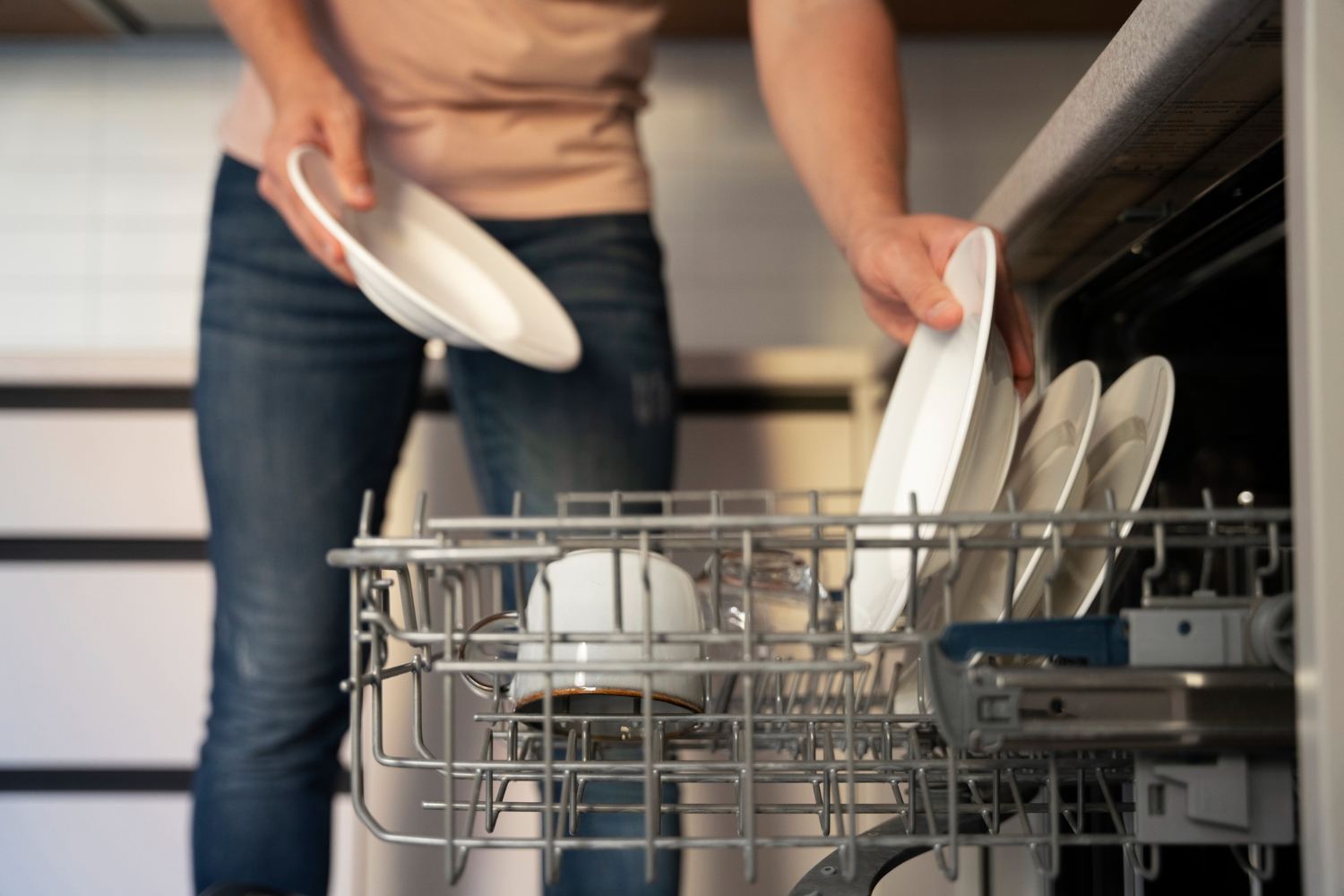A dishwasher is one of the most convenient appliances in any home, quietly taking care of dirty plates, greasy pans, and sticky glasses. But even though it’s built to clean, the dishwasher itself needs regular attention. Over time, food particles, grease, and detergent residue collect inside, leading to unpleasant odors, cloudy glasses, and even reduced cleaning power. If you’ve ever noticed a strange smell when you open the door or found your dishes coming out less than spotless, chances are your dishwasher is overdue for a thorough clean.
Learning how to clean dishwasher properly not only improves performance but also extends its lifespan. A well-maintained machine uses water more efficiently, prevents costly repairs, and keeps your kitchen running smoothly. This guide will walk you through each step, showing you exactly how to bring your dishwasher back to peak condition using simple, affordable methods you can do at home.
Understanding What Builds Up Inside a Dishwasher
It may be surprising to learn just how much buildup can accumulate inside a dishwasher. Each cycle rinses away food, but tiny bits of debris still cling to filters, racks, and seals. Grease and soap scum settle along interior walls, creating a thin film that dulls the shine of dishes. In areas with hard water, mineral deposits form stubborn white spots and limescale, clogging parts like spray arms.
The design of a dishwasher also creates hidden corners where grime loves to hide. The gasket around the door, the drain at the bottom, and the tiny holes in the spray arms can all trap residue. Over time, these overlooked spots reduce water pressure and circulation, leaving you with dishes that don’t look or smell clean.
Understanding these problem areas is the first step to knowing how to clean dishwasher effectively. Once you know what causes buildup, you can target each part with the right cleaning method.
Preparing Your Dishwasher Before Cleaning
Before diving into the actual cleaning, take a few minutes to prepare your dishwasher. Start by removing any dishes, utensils, or racks so you have full access to the interior. This ensures nothing gets in the way and allows you to reach every surface.
Next, gather a few basic supplies. Most deep cleaning methods rely on simple household items such as white vinegar, baking soda, a soft cloth, a sponge, and an old toothbrush for detail work. If your dishwasher has mineral buildup, you may also want a descaling solution or a dishwasher cleaning tablet.
It’s also a good idea to double-check for safety. Turn off the dishwasher, ensure it’s empty, and keep electrical components dry while cleaning the control panel. With everything ready, you can now focus on tackling each section of the machine step by step.
Cleaning the Dishwasher Filter and Drain
The filter is the heart of your dishwasher’s cleaning power. It traps leftover food particles so they don’t redeposit on your dishes, but if it becomes clogged, water circulation slows down, and odors develop.
To clean it, locate the filter at the bottom of the dishwasher, usually under the lower spray arm. Twist it out gently, rinse it under warm water, and use a soft brush to scrub away greasy residue. Avoid harsh tools that might damage the mesh.
While the filter is out, inspect the drain area. Food scraps often settle here, creating a hidden source of odor. Remove any visible debris with a paper towel or cloth. A clean filter and drain keep water flowing smoothly, which is essential for sparkling dishes.
Deep Cleaning the Interior Surfaces
Once the filter is clean, focus on the walls, racks, and seals. Even stainless-steel interiors can look dull when covered in soap film. Use a damp cloth with mild dish soap to wipe down every surface, including the inside of the door. Pay special attention to the rubber gasket, which often traps crumbs and moisture.
Hidden grime also collects where racks slide in and out. Pull them out completely, wipe them down, and check for cracks or worn wheels. This small step not only keeps your dishwasher clean but also makes it easier to load dishes smoothly.
If you have a stainless-steel interior, avoid abrasive scrubbing pads that could scratch the surface. A microfiber cloth works best, leaving a polished finish that reflects cleanliness.
Using Vinegar and Baking Soda for a Fresh Wash
For a natural, budget-friendly cleaning boost, vinegar and baking soda are your best friends. Start by placing a dishwasher-safe cup filled with white vinegar on the top rack. Run a hot water cycle without any dishes. The vinegar breaks down grease, kills lingering odors, and dissolves soap scum.
Once that cycle is done, sprinkle a cup of baking soda evenly across the bottom of the dishwasher. Run a short, hot rinse cycle. The baking soda neutralizes odors and brightens the interior, leaving your machine fresh and clean.
This two-step method is one of the most effective ways to keep your dishwasher in peak condition without harsh chemicals. It’s also an excellent monthly routine for anyone learning how to clean dishwasher naturally.
Dealing with Hard Water and Limescale
If you live in an area with hard water, mineral deposits are inevitable. These show up as cloudy spots on glassware, chalky streaks inside the dishwasher, or clogged spray arms. Not only are they unattractive, but they also interfere with performance.
To handle limescale, you can use a descaling solution designed for dishwashers. Alternatively, running an empty cycle with vinegar can help reduce buildup. For stubborn areas, a paste of baking soda and water can be applied directly to affected spots.
Preventing future buildup often means adding a rinse aid or using dishwasher tablets that include limescale protection. Keeping this step in your routine ensures your dishwasher continues to deliver crystal-clear results.
Cleaning the Spray Arms for Better Performance
Spray arms play a crucial role in cleaning by blasting water across every dish. Over time, their small holes can clog with food particles or minerals, reducing water pressure.
To clean them, remove the spray arms by unscrewing or gently pulling them out, depending on your model. Rinse them under warm water and use a toothpick or thin wire to clear any blocked holes. Once clean, reinstall them securely and give them a quick spin to ensure they rotate freely.
This simple step makes a noticeable difference in how well your dishwasher cleans. If you’ve ever wondered why your dishes still look dirty after a cycle, clogged spray arms might be the hidden culprit.
Keeping the Exterior Sparkling
While the inside does the heavy lifting, the outside of your dishwasher also deserves care. Smudges, fingerprints, and streaks can make even a clean kitchen look untidy.
For control panels and buttons, wipe them gently with a damp cloth. Avoid soaking them, as excess moisture can damage electronics. For stainless-steel exteriors, use a dedicated cleaner or simply buff with vinegar and a microfiber cloth for a streak-free shine.
A polished exterior not only looks good but also reflects the pride you take in maintaining your kitchen appliances.
How Often Should You Clean Your Dishwasher?
Knowing how to clean dishwasher is only part of the equation—keeping up with a regular schedule makes all the difference. Experts recommend rinsing the filter weekly, running a vinegar cycle monthly, and performing a deep clean every three to four months.
To keep odors at bay between cleanings, scrape food from plates before loading them and leave the door slightly ajar after a cycle to let moisture escape. These small habits go a long way in preventing buildup and keeping your dishwasher smelling fresh.
Conclusion: A Cleaner Dishwasher Means Cleaner Dishes
Regular maintenance may seem like a chore, but it pays off in performance, hygiene, and long-term savings. By taking the time to clean the filter, scrub interior surfaces, run vinegar and baking soda cycles, and tackle limescale, you ensure your dishwasher works at its best.
When you know how to clean dishwasher properly, you don’t just get sparkling dishes—you extend the life of one of the most important appliances in your home. With a little effort and a consistent routine, your dishwasher will stay fresh, efficient, and ready to handle every load with ease.
My name is Mustafa, and I have been blogging for over 5 years. I am passionate about sharing complete, accurate, and helpful information with my readers. Along with managing content on The Matcha Read, I also contribute blog posts to premium websites. My goal is to provide valuable insights in a clear and easy-to-understand way, so every reader walks away with useful knowledge.










